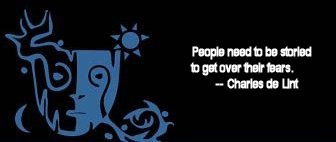|

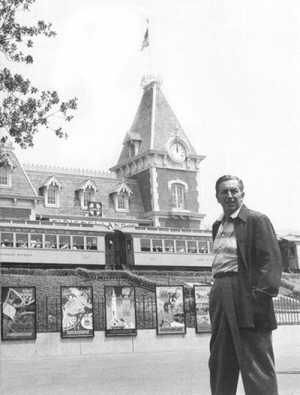 Walt Disney Builds Walt Disney Builds
the Cosmos Electric
by John David Ebert
Of Landscapes & Iconoscopes
Walt Disney was one of the first men to hook up the comic strip to an electric battery. In doing so, the flow of current created a whole new world of forms as stylistically distinct and unique as the broad, syncopated spaces of Chinese landscape paintings. For the cartoon universe obeys its own laws, laws which are similar to those of non-Euclidean geometry, in which physical and mechanical forms bend and curve and warp like Einsteinian space around massive objects. And, just as the speed-of-light theologies of Relativity made the laws of Newtonian mechanics obsolete, so too, in the realm of cartoon cosmology, machines are reabsorbed and resolved back into the substrate of an organic and animistic worldview in which locomotives transform into hungry, coal-devouring dinosaurs, while suburban tract houses change into aeroplanes and automobiles grow layers of human skin, their headlights gazing with the milky, nictitating membranes of reptiles. Physical bodies in this cosmos, whether human or animal, bend and stretch like Silly Putty™, while domestic objects such as pianos or tables and chairs grow legs and arms in order to move about with their own misguided wills.
Such a world, though unique, did not just emerge full blown out of the head of Walt Disney in the early 1920's when he first began his animation experiments, or even out of the heads of his predecessors in the genre such as Winsor McCay ("Gerty the Dinosaur") and Otto Messmer ("Felix the Cat"). Indeed, throughout the course of the nineteenth century from as far back as Mary Shelley who, with her 1817 novel Frankenstein, was the first author to animate a living creature by means of an electric current, to Lewis Carroll who, in 1865, with his novel Alice in Wonderland, was the first to take a character out of the containing walls of Euclidean space and put her into the non-Euclidean world of an electrically-charged landscape, there had been a gradually increasing rate of incursion of electrically-inspired tropes into Western literature.
 Lewis Carroll's two Alice novels, in particular, provide us with a glimpse into the coming world of animated cartoons, for when Alice takes her plunge down that rabbit hole, the world that she encounters is one that bends, stretches and flattens as though it had been accelerated to the speed of light. Alice herself undergoes many spatial distortions, now shrinking to the size of a mushroom, now expanding to the scale of a giant, while the world around her remains disproportionate to her metamorphoses. Alice, in short, no longer occupies the universe shared by the makers of the mechanical cosmos of Newton and Laplace, in which space was conceived as a homogenous container within which objects were placed, all subordinated to the same dimensions. Alice's world is decidedly the electro-magnetic universe of James Clerk Maxwell and Einstein, in which multiple spaces and times all coexist simultaneously without bearing any necessary relationship to each other. Indeed, the very form of Carroll's narratives demonstrates this, for each chapter is a virtually self-contained episode with little relation to any of the others: the Mad Tea Party has little bearing on what precedes it or on the Croquet Game which follows it, which in turn has almost nothing to do with the Mad Trial which succeeds it. In short, Alice in Wonderland is a mosaic of disconnected spaces and relations all juxtaposed beside one another like the articles in a newspaper. Such spaces exist in a field of simultaneous relations, exactly like the fields of Einsteinian Relativity, in which each observer moves in his own frame of reference while carving out his own space and his own time relative to all the others. Lewis Carroll's two Alice novels, in particular, provide us with a glimpse into the coming world of animated cartoons, for when Alice takes her plunge down that rabbit hole, the world that she encounters is one that bends, stretches and flattens as though it had been accelerated to the speed of light. Alice herself undergoes many spatial distortions, now shrinking to the size of a mushroom, now expanding to the scale of a giant, while the world around her remains disproportionate to her metamorphoses. Alice, in short, no longer occupies the universe shared by the makers of the mechanical cosmos of Newton and Laplace, in which space was conceived as a homogenous container within which objects were placed, all subordinated to the same dimensions. Alice's world is decidedly the electro-magnetic universe of James Clerk Maxwell and Einstein, in which multiple spaces and times all coexist simultaneously without bearing any necessary relationship to each other. Indeed, the very form of Carroll's narratives demonstrates this, for each chapter is a virtually self-contained episode with little relation to any of the others: the Mad Tea Party has little bearing on what precedes it or on the Croquet Game which follows it, which in turn has almost nothing to do with the Mad Trial which succeeds it. In short, Alice in Wonderland is a mosaic of disconnected spaces and relations all juxtaposed beside one another like the articles in a newspaper. Such spaces exist in a field of simultaneous relations, exactly like the fields of Einsteinian Relativity, in which each observer moves in his own frame of reference while carving out his own space and his own time relative to all the others.
The disconnected, aperspectival landscapes of Carroll's novels were presupposed by Disney as basic vectors charting the universe within which his imagination roamed. From his early Laugh-O-Gram cartoon shorts, in which a live action Alice wanders about a cartoon realm, to his 1951 adaptation of Carroll's novel, and even further, to the building of Disneyland with its aperspectival theme park in which disparate worlds wholly unconnected with each other are set side by side, the world of the Alice novels provided Walt Disney with the requisite maps for charting his navigations through the New Worlds created by electric society.
Of Mice & Megamachines
At the conclusion of Through the Looking Glass, there are two illustrations by Tenniel which are nearly identical, although one illustrates the hands of Alice holding her cat, while the other, which is meant to be the cat's reflection in Looking Glass World — for it is in exactly the same position — shows her holding the Red Queen chess piece instead of the cat. Thus, through the iconic world of the Looking Glass, Alice's cat becomes the Red Queen (just as her other kitten becomes the White Queen) for Looking Glass World reflects back not images of the physical body but masked apparitions of one's imaginal body. Likewise, when Walt Disney gazed at himself through the looking glass equivalent of the electric iconoscope, the image which was reflected back at him bore the strangely distorted features of a mouse. Mickey Mouse was the mask worn by Walt Disney as he ventured through the early years of his cartoon Wonderlandscapes. (It is well known that Mickey Mouse really was Walt Disney, scaled down like Alice and transformed into his Looking Glass World equivalent [Walt even provided Mickey's voice in the early black and white cartoons]).
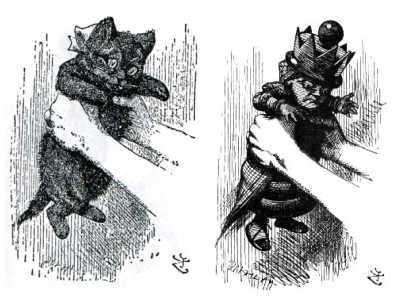
Mickey Mouse was conceived by Disney during one of the darkest periods of his life, when his school of animators had defected to a rival power and his character Oswald the Lucky Rabbit had been taken away from him through legal chicaneries. The mouse figure that surfaced out of his imagination was a response to this period of despair, for it was the mouse that saved his career and put him back on the path toward success as an animator. That he happened to conceive specifically of a mouse at just this time does not appear to have been accidental, either, for mice in ancient myth are traditionally thought of as having great powers out of all proportion to their size. Indeed, they are often able to bring down the mighty in cases where more apparently formidable powers fail. In 1 Samuel, for instance, the Philistines are punished for daring to kidnap the Ark of the Covenant by a plague of mice which so terrorizes them that they are inspired to return the ark along with five golden mice as symbols of sympathetic magic to make the plague go away.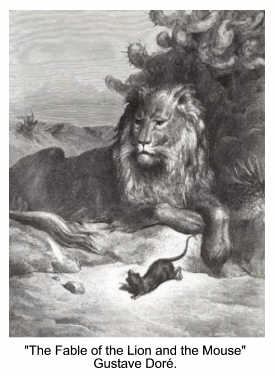 Apocryphal accounts describe the Devil as having taken on the form of a mouse and attempting to gnaw a hole through Noah's ark, stopped only by a lion. McLuhan quotes Alexander Pope to the effect that "the Dutch stories somewhere relate, that a great part of their Provinces was once overflow'd, by a small opening made in one of their dykes by a single Water-Rat." (McLuhan, 263) And though mice in Aesop's Fables tend to fare badly, in at least one famous story, that of "The Lion and the Mouse," the mouse's diminutive size enables it to perform the mighty feat of liberating the lion from the hunter's net that has ensnared him. (This story, apparently, has its prototype in the Hindu collection of fables known as the Panchatantra, in which the mice set free an entire herd of elephants from the snares of the hunter's traps.) Despite its size, the mouse is able to strike terror into the heart of a beast so mighty as the elephant, which is perhaps why Ganesha, the elephant-headed Hindu god of commerce is depicted as riding on the back of a mouse. (In Hindu symbology, according to Alain Danielou, the mouse is a thief which lives in the hole of the intellect, where it symbolizes the mighty Brahman.) In Greece, the mouse was connected with another great deity, the sun god Apollo, who was known in this aspect as Smintheus, the mouse god, for Apollo was known and feared as the bringer of plagues. And in the so-called "mouse tower" stories of Northern Europe, miserly bishops and ecclesiastical men are punished for their niggardliness by hordes of avenging mice who eat them alive. Apocryphal accounts describe the Devil as having taken on the form of a mouse and attempting to gnaw a hole through Noah's ark, stopped only by a lion. McLuhan quotes Alexander Pope to the effect that "the Dutch stories somewhere relate, that a great part of their Provinces was once overflow'd, by a small opening made in one of their dykes by a single Water-Rat." (McLuhan, 263) And though mice in Aesop's Fables tend to fare badly, in at least one famous story, that of "The Lion and the Mouse," the mouse's diminutive size enables it to perform the mighty feat of liberating the lion from the hunter's net that has ensnared him. (This story, apparently, has its prototype in the Hindu collection of fables known as the Panchatantra, in which the mice set free an entire herd of elephants from the snares of the hunter's traps.) Despite its size, the mouse is able to strike terror into the heart of a beast so mighty as the elephant, which is perhaps why Ganesha, the elephant-headed Hindu god of commerce is depicted as riding on the back of a mouse. (In Hindu symbology, according to Alain Danielou, the mouse is a thief which lives in the hole of the intellect, where it symbolizes the mighty Brahman.) In Greece, the mouse was connected with another great deity, the sun god Apollo, who was known in this aspect as Smintheus, the mouse god, for Apollo was known and feared as the bringer of plagues. And in the so-called "mouse tower" stories of Northern Europe, miserly bishops and ecclesiastical men are punished for their niggardliness by hordes of avenging mice who eat them alive.
Apparently, then, the mouse, despite its size, is a force to be reckoned with. Walt Disney's cartoon doppelganger, Mickey Mouse, was called forth out of the depths as a mythic figure traditionally capable of battling successfully against overwhelming odds in order to help him survive the early loss of his first studio. But it so happened that this character appeared at a time when America as a whole was about to enter the Great Depression, and the image of a persistent mouse appealed to the imagination of the country as metaphoric of the little guy overwhelmed by circumstances spiraling out of control aro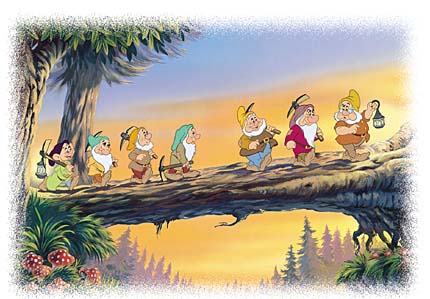 und him while just barely managing to stay afloat. und him while just barely managing to stay afloat.
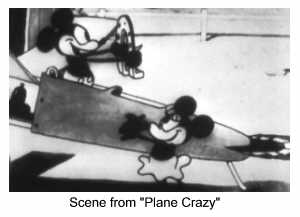 In the cartoon shorts made by Disney and his animators (the first Mickey Mouse cartoon was "Plane Crazy" in 1928), Mickey Mouse is forever battling for control over an environment that threatens to undo him. Whether he is fighting a recalcitrant piano in "Ole Opry," or a house full of spooks in "Mickey and the Haunted House," or a train that has gone out of control in "Mickey's Choo Choo," Mickey is perpetually attempting to bring order to an environment that is nearly beyond his grasp. Thus, the tiny mouse fighting successfully against the powers of the almighty Megamachine was an image that appealed to the entire country and helps to explain the popularity of Mickey Mouse during the early 1930's. In the cartoon shorts made by Disney and his animators (the first Mickey Mouse cartoon was "Plane Crazy" in 1928), Mickey Mouse is forever battling for control over an environment that threatens to undo him. Whether he is fighting a recalcitrant piano in "Ole Opry," or a house full of spooks in "Mickey and the Haunted House," or a train that has gone out of control in "Mickey's Choo Choo," Mickey is perpetually attempting to bring order to an environment that is nearly beyond his grasp. Thus, the tiny mouse fighting successfully against the powers of the almighty Megamachine was an image that appealed to the entire country and helps to explain the popularity of Mickey Mouse during the early 1930's.
Over time, Disney will become more and more obsessed with controlling his environment, and in these early images of Mickey Mouse fighting for control over a world that nearly destroys him, we can see Disney himself fighting desperately for control over his career, a control that he would, by the end of his life, come to take for granted.
Of Dwarves & Mountains
If Disney's first two masks were the Alice character of his Laugh-O-Gram shorts in the 1920's, followed by Mickey Mouse in the early 1930's, then with his creation of the first feature-length animated movies, Snow White and the Seven Dwarves in 1937 and Pinocchio in 1940, the problem shifted from the personae of his alter egos to that of his relationship with his muse. Snow White is Disney's muse, and her stay with the seven dwarves is highly symbolic of a number of initiatory processes all rolled up together into one tapestry.
 On the face of it, the story of Snow White as found in The Brothers Grimm is a tale of the transformation of a naïve young girl into a sexually receptive and mature adult woman ready to bear progeny, of which the seven dwarves, with their child-like stature, and Snow White's matronly attitude toward them, are a foreshadowing. However, if we dig deeper, we realize that the dwarves are smiths, and since smiths in mythology are normally associated with the magical power of transmuting raw ores into metals, and of metals into weapons with mysterious and dangerous properties, it cannot escape our notice that Snow White's temporary stay with the dwarves in their cottage must have something to do with this process. As Jung has pointed out, there is an analogy between the maturation of the psyche and the transmutation of base metals into gold, and so the dwarves must be regarded symbolically as "obstetricians" whose responsibility it is to help bring about the birth of Snow White's mature personality. Eliade, in his book The Forge and the Crucible, has pointed out the obstetrical symbolism traditionally associated with the transformation of ores, analogized as embryos, into metals, which are thus born as "children" once ripened by the art. The earth is the mother within which the smith finds these ores in their embryonic state, and it is his task to midwive them into fully ripened and mature metals, separated from their mineralogical contaminations. On the face of it, the story of Snow White as found in The Brothers Grimm is a tale of the transformation of a naïve young girl into a sexually receptive and mature adult woman ready to bear progeny, of which the seven dwarves, with their child-like stature, and Snow White's matronly attitude toward them, are a foreshadowing. However, if we dig deeper, we realize that the dwarves are smiths, and since smiths in mythology are normally associated with the magical power of transmuting raw ores into metals, and of metals into weapons with mysterious and dangerous properties, it cannot escape our notice that Snow White's temporary stay with the dwarves in their cottage must have something to do with this process. As Jung has pointed out, there is an analogy between the maturation of the psyche and the transmutation of base metals into gold, and so the dwarves must be regarded symbolically as "obstetricians" whose responsibility it is to help bring about the birth of Snow White's mature personality. Eliade, in his book The Forge and the Crucible, has pointed out the obstetrical symbolism traditionally associated with the transformation of ores, analogized as embryos, into metals, which are thus born as "children" once ripened by the art. The earth is the mother within which the smith finds these ores in their embryonic state, and it is his task to midwive them into fully ripened and mature metals, separated from their mineralogical contaminations.
Snow White's stay in the cottage of the dwarves is analogous to Persephone's journey to the underworld, for dwarves are workers in the underworld of caves, where they are thought to dwell (since exposure to sunlight would transform them into stone), forever digging up precious gems and minerals. Snow White, then, has really gone down with them into their cavernous underworld, where they are able to weave their magic upon her simply by their presence.
In the ancient world, metals were archetypally associated with the planets: the sun with gold, the moon with silver, Mercury with quicksilver, Jupiter with tin, Mars with iron, Venus with copper and Saturn with lead. By naming each of the dwarves, something which does not occur in the Grimm tale, Disney underlines the fact that each dwarf, like each of the planets, is associated with a different archetypal quality. Mars, for instance, was associated with courage, Venus with Eros, Jupiter with Regality, Saturn with Melancholy, and so on. Hence, Dopey, Sleepy, Grumpy, Sneezy, etc., each embody a separate archetypal quality which is in process of being imprinted upon Snow White's soul.
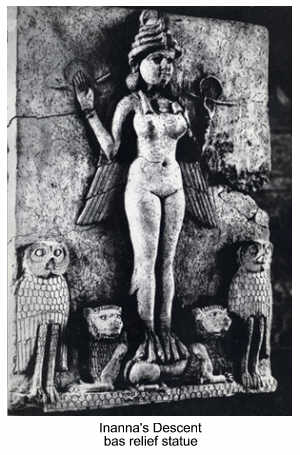 In the classical world, the soul at the moment of its incarnation here on earth was thought of as having arrived at the end of a journey through the seven planetary spheres where it has picked up a different archetypal quality at each one. When, in the Mesopotamian myth of "Inanna's Descent to the Netherworld," the goddess must carefully and deliberately remove a different article of clothing for a total of seven pieces in all before standing naked in the underworld at the throne of the Queen of the Dead, we realize that we are in the presence of the Near Eastern prototype of this classical myth, only here it is reversed, for in death, the soul must shed each layer of archetypal clothing within which it had been cocooned at birth. In the classical world, the soul at the moment of its incarnation here on earth was thought of as having arrived at the end of a journey through the seven planetary spheres where it has picked up a different archetypal quality at each one. When, in the Mesopotamian myth of "Inanna's Descent to the Netherworld," the goddess must carefully and deliberately remove a different article of clothing for a total of seven pieces in all before standing naked in the underworld at the throne of the Queen of the Dead, we realize that we are in the presence of the Near Eastern prototype of this classical myth, only here it is reversed, for in death, the soul must shed each layer of archetypal clothing within which it had been cocooned at birth.
Snow White's sojourn among the dwarves is really an image of the transformation of Disney's muse into a new and complex entity that, at the moment of its rebirth by way of the Prince's kiss, will be ready to inspire him with new creative children of his own. The dwarves, on this analogy, have multiple layers of reference, too, for if they refer to the seven archetypal qualities of the planets or their metals, they are also analogues for the animators of Disney's new studio whose task it was to bring Snow White into vivid Technicolor life through the craft of their laborious art. In doing so, they created a great work of celluloid art, Disney's first feature film, and also his best, one that he would never surpass.
Thus, with Snow White and the Seven Dwarves, Disney's animators animated Disney's muse, and in doing so, transformed the raw materials of the Grimms' tale into the gold of the world's first great feature length cartoon.
Of Puppets & Gods
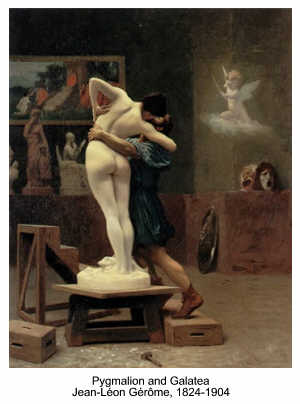 The story of Pinocchio, based upon an Italian children's novel by Carlo Collodi, is essentially a reworking of the myth of Pygmalion and Galatea, although with the presence of Shelley's Frankenstein looming like a mountain over the literary landscape of the nineteenth century, the role of lover and beloved has been changed to that of father and son. In Collodi's novel, Gepetto carves Pinocchio from a block of wood that is already animate with Pinocchio's presence — which hurls insulting and abusive comments at him — as though it were Gepetto's task merely to free the imprisoned child from the block of wood. But Disney changes the opening sequence, as he changes most of Collodi's novel, so that when the film opens, Gepetto has already assembled an inert and inactive Pinocchio who rests on the workbench waiting for the finishing touches of eyebrows and mouth. Gepetto puts himself to bed, wishing that his creation were a real boy, and as he sleeps, his prayer is answered — by a pagan divinity — when the Blue Fairy shows up and brings Pinocchio to life. In making this change, Disney actually brings the story closer to the Pygmalion myth, for in that story, Pygmalion carves the statue of a beautiful woman and then prays to the goddess Venus to bring her to life, which she does. The story of Pinocchio, based upon an Italian children's novel by Carlo Collodi, is essentially a reworking of the myth of Pygmalion and Galatea, although with the presence of Shelley's Frankenstein looming like a mountain over the literary landscape of the nineteenth century, the role of lover and beloved has been changed to that of father and son. In Collodi's novel, Gepetto carves Pinocchio from a block of wood that is already animate with Pinocchio's presence — which hurls insulting and abusive comments at him — as though it were Gepetto's task merely to free the imprisoned child from the block of wood. But Disney changes the opening sequence, as he changes most of Collodi's novel, so that when the film opens, Gepetto has already assembled an inert and inactive Pinocchio who rests on the workbench waiting for the finishing touches of eyebrows and mouth. Gepetto puts himself to bed, wishing that his creation were a real boy, and as he sleeps, his prayer is answered — by a pagan divinity — when the Blue Fairy shows up and brings Pinocchio to life. In making this change, Disney actually brings the story closer to the Pygmalion myth, for in that story, Pygmalion carves the statue of a beautiful woman and then prays to the goddess Venus to bring her to life, which she does.
We note that the Blue Fairy resembles a Hollywood movie actress, for she is actually another version of Disney's celluloid muse who has come to bring his animation cels to life by the power of electricity. The spark which she confers on Pinocchio is not like the spiritual pneuma given by God to the outstretched hand of Adam in Michelangelo's Sistine Chapel painting, but rather it is the current of electricity that powers the very movie cameras and projectors that will conjure forth the illusion of Pinocchio's Technicolor existence. Gepetto's toyshop is really Disney's animation studio within which his dreams are brought to life by his animators, and Gepetto himself is now Disney's alter ego, the new mask that he has put on in order to assume the role of film director of animate illusions. (Later, Disney will don the Gepetto mask once again for the forging of his Audio-Animatronic robots by means of which he will create his own artificial human beings).
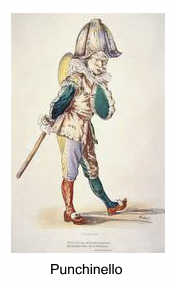 In the novel, the very moment that Gepetto finishes carving his creation, the boy simply springs out the door and runs off, leaving Gepetto to be thrown into jail for threats of child abuse. The wooden boy thereupon undergoes a series of very unDisneyesque misadventures which Disney was careful to eliminate from his version of the story. Pinocchio, for instance, rests his feet on a burning brazier and falls asleep only to awaken and find them burned off. The talking cricket which serves as the prototype for Jiminy Cricket is immediately smashed by Pinocchio with a mallet when the cricket reminds him that he is on a wayward path. Later, when Pinocchio falls in with bad company, the Fox and the Cat, they manage to trick him out of his gold coins and try to kill him by hanging him from an oak tree, where he nearly chokes to death. None of these episodes are suitable to the spirit of a Walt Disney film, but they are very consistent with the Punchinello/Harlequin world of Italian puppetry. In the novel, the very moment that Gepetto finishes carving his creation, the boy simply springs out the door and runs off, leaving Gepetto to be thrown into jail for threats of child abuse. The wooden boy thereupon undergoes a series of very unDisneyesque misadventures which Disney was careful to eliminate from his version of the story. Pinocchio, for instance, rests his feet on a burning brazier and falls asleep only to awaken and find them burned off. The talking cricket which serves as the prototype for Jiminy Cricket is immediately smashed by Pinocchio with a mallet when the cricket reminds him that he is on a wayward path. Later, when Pinocchio falls in with bad company, the Fox and the Cat, they manage to trick him out of his gold coins and try to kill him by hanging him from an oak tree, where he nearly chokes to death. None of these episodes are suitable to the spirit of a Walt Disney film, but they are very consistent with the Punchinello/Harlequin world of Italian puppetry.
Thus, with his second film, Disney moves from the world of the Gothic, Germanic north, with its Brothers Grimm and their creepy fairy tales, to the bright, sunny Mediterranean realm of Italian puppet plays and carnivals. The color palettes of the two films reflect this dichotomy, for the colors of Snow White are generally dark and muted, bruised purples and rotting fruit, while the palette of Pinocchio is closer to the primary colors of his Donald Duck cartoons, bright and gay with lots of vivid blues and greens and reds. (The German Protestant North is the land where the word took precedence over the image, for images were expunged from churches by the Protestants, who laid the foundation for Biblical scholarship by insisting upon the text, rather than the priesthood, as the authoritative word of God. The Catholic South, on the other hand, emphasized the tradition of imagery and painting, with its gruesome visions of tortured and bleeding saints. Hence, in Snow White, the wicked witch with her magical potions becomes the prototype of the German scientist who alters the very structure of the material world by absconding with its deepest secrets, while in Pinocchio, there is no magic, and there are no magicians — for science, with few exceptions, did not come out of southern Europe — and all its supernatural powers descend like visiting angels from the heavens above, such as the Blue Fairy who intercedes in the narrative at a number of key points like an angel out of Catholic mythology).
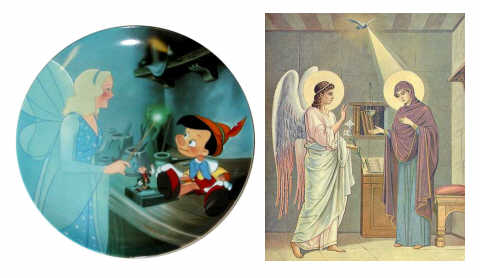
Both films open by paying homage to the very Gutenbergian Galaxy which Disney's work is paying farewell to, for they begin with images of books whose pages are turned in order to begin their stories proper. This is a vestigial relic of the Gutenbergian world, like the ornate and florid capital letters that traditionally began each chapter of a printed book, which were carryovers from the illuminated manuscripts displaced by the printing press. Disney soon drops the allusion, for by the time of Dumbo, the references to the printed book are gone (although they resurface in Cinderella and Sleeping Beauty). But Disney's films resemble not so much animated books or cartoons, as moving stained glass, for Disney is attempting to immerse the viewer inside an electronic cathedral in which he gazes out upon the lives of fairy tale figures just as, once upon a time, the pious worshipper would have attempted to mentally animate the stories of the lives of the saints which towered above him in the tracery of Gothic windows. (Witness the climax of Fantasia, in which Disney very consciously places the viewer inside a cathedral made out of a forest of stylized trees set to the music of Schubert's Ave Maria).
The point here is that Disney's aspirations all along have been of a religious nature, although most likely this was not conscious on his part. Nevertheless, as his career unfolds, he slowly and methodically sets about the creation of an electronic religion, casting himself in the role of prophet and messiah. By the end of his career, this role would enlarge to become that of a creator deity whose avatars occasionally descended into his dreamworlds in order to tinker with them, now as a Gepetto, now as an Alice, now as a Mickey Mouse.
In the end, he would strive to become a god.
Of Lost Boys & Wonderlands
Disney's first three feature length films, Snow White and the Seven Dwarves, Pinocchio and Fantasia were his best. They are, in a real sense, masterpieces, but the same cannot be said of any of the other films which followed, all of which, from Dumbo onward, are on an inclined plane downward in terms of the integrity and quality of his vision. Due to the budgetary problems resulting from the financial failures of Pinocchio and Fantasia, and then with Bambi, which was a total flop, he was plunged into an eight year period of financial compromises which nearly wiped out his studio. All of this took place during the early 1940's, Disney's dark years, when the U.S. government conscripted his studio into making technical and educational films. When the war ended, Disney was so disoriented and confused by the failure of his mythic vision that he seems not to have had any idea what sort of film to make, and so a string of bad movies followed.
It was not until the release of Cinderella in 1950 that he was to make a comeback, but by this time, his vision had been so diluted and compromised as to be virtually unrecognizable. He had become removed from the making of his own films, generally delegating them to his staff, and his lack of interest is evident in Cinderella, for though the film was a financial and critical success, its animation is lackluster, basically no different from the average Bugs Bunny cartoon, and the story has been almost completely garbled by Disney's staff who obviously did not understand the fairy tale. Disney, by this point, had routinized his own charisma.
However, with his 1951 adaptation of Lewis Carroll's Alice in Wonderland, which followed Cinderella, he nearly achieved a return to form, for this film, contrary to popular opinion, is one of Disney's best, and hearkens back to the early years, inviting comparison especially to Fantasia, to which it alludes at a number of points. With this film, Disney returned to the cartoon Wonderland that had inspired his initial vision and created a film that is entirely faithful to the spirit of Carroll's book. Here, Alice becomes Disney's alter ego once again, returned for another journey through the labyrinth of Wonderland, as a sort of dress rehearsal for the creation of Disneyland, for Disneyland is a three-dimensional realization of Lewis Carroll's cartoon cosmos.
Peter Pan, which followed Alice in Wonderland in 1953, though technically inferior in terms of its animation, is nonetheless one of Disney's better films, for it represents his vision in a way that is archetypically Disneyesque. Here, Peter Pan has traded places with Alice as Disney's alter ego, for Disney is the boy who never grew up. Neverland is another version of Wonderland, for it too, is a realm of mythical archetypes in which nothing ever changes, no one ever ages, and where the shadow of Time never falls. Peter Pan is also a forerunner of Disneyland, for there is a shot in the film in which Neverland is depicted as an island which Peter and Wendy and the boys look down upon from the air above, and which bears a striking resemblance to early maps and drawings of Disneyland. Neverland itself, furthermore, was miniaturized to occupy a quadrant of Disneyland, for in Fantasyland, the pirate cove and ship are taken directly from that film.
Thus, with Cinderella we see Disney's muse liberated from the ashes of mourning where Disney had been for the previous eight years grieving over the loss of his muse (in traditional forms of mourning, one smears oneself with ashes, and in Grimm's Fairy Tales, "Aschenputtel" is the title of their version of Cinderella). Once his muse had been reawakened and freed from her drudgeries, he proceeded to dust off the yellowing old maps that had provided the cartography to his initial worldview with Alice in Wonderland, a book which had formed a constant leitmotif throughout his career. It was essential at this point, while he was planning out his amusement park, to pay his respects to his forerunner Lewis Carroll (or "Lewd's Carol" as James Joyce calls him) whose Wonderland was composed of the same electric landscape of spatial distortions and optical tricks that would form the basic design concerns of Disneyland. That done, Disney then removed the Alice mask and put on the tribal mask of Peter Pan — for Peter Pan is essentially the tribal chieftain of the Lost Boys, a British social structure that prefigures the coming of the great British rock bands, with all their tribal motifs — to become the boy who eschewed reality, the banal world of jobs and domestic drudgeries, in order to wander through Neverland, the perfect template for the type of microcosmos that Disney himself wished to build: a place where no one would ever have to grow up at all.
Of Model Trains & Giant Doll Houses
If Disney, by the early 1950's, had become less interested in making films, it was because a new project was draining off all his creative energy into its own reservoirs. In the late 1940's, Disney had become fascinated with model trains, beginning first with electric trains, and then moving on to more expensive miniature steam locomotives. Indeed, he had become so obsessed with them, that he moved his family to a new property with a backyard that was large enough to accommodate the train upon which he was able to sit as it carried him around the perimeter and through the tunnels of the yard.
Then he began experimenting with recreating doll house-sized movie sets of vanished epochs of turn of the century Americana. He gathered together a collection of these sets and put them into an exhibition which he called "Disneylandia." Then he started thinking about the possibility of blowing up these doll house miniatures of a vanished world to life size, and so put his mind, and some members of his staff, to work on planning out the creation of an amusement park that would be based upon a reconstruction of the small towns of turn of the century America. Thus, the first drawings for Disneyland show what would later become scaled down to occupy merely one quadrant of the amusement park, Main Street, USA, with its general store and quaint shop fronts.
Once again, as is always the case with Disney, the problem is a matter of scale. He thinks in terms of the spatial discontinuities of Alice in Wonderland, for at first he blows up his electric trains to the size of miniature steam locomotives; then he enlarges his doll house displays to the size of a theme park, to be circumscribed by a real locomotive as its boundary. These maneuvers are virtually an imitation of the scalings up and scalings down of Alice at the beginning of her Wonderland adventure when she approaches a door that is much too small for her to enter, and so drinks a potion that shrinks her down to three inches, but which makes her too small to reach the gigantic key that is still left up on the table now out of her reach. When she drinks the potion again, she is blown up to the size of a giant who can barely fit inside the tunnel and when she begins to cry, her huge teardrops form a flood that carries her through the portal and out into Wonderland together with a group of washed up animals.
Such spatial discontinuities, furthermore, are precisely characteristic of the cosmos electric, which is aperspectival and discontinuous, and in which each object occupies its own space without any relationship to adjacent objects. Here in Einsteinland, each clock moves at its own time, for clocks that are closer to the ground move more slowly than clocks that are higher up in the air, while objects, as they approach light speed, contract in the direction of their motion and become weirdly elongated. Cause and effect are turned upside down such that the effect may even precede the cause, just as the Mad Hatter's incarceration actually precedes his trial and sentencing.
With the creation of Disneyland, then, Disney decides to enlarge his miniature playsets and model trains so that everyone can play these lightspeed games along with him. However, in the spirit of Lewis Carroll, it is perhaps just as true to say that Disney actually shrank the rest of us down to the level of Alice in the garden talking to the blue caterpillar on a mushroom so that we could enter his playsets while he loomed above us like a god, controlling now this effect, now that.
Of Mandalas & World History
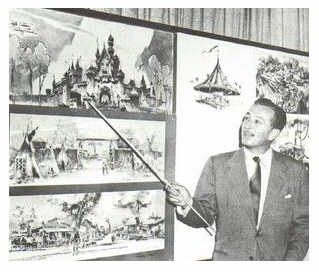 The early maps of Disneyland resemble a Tibetan mandala, divided into four quadrants: the southern quadrant is Main Street, USA, which is the first thing one encounters upon entering the park; to the north, the miniature castle that terminates the vanishing point of the view along Main Street, indicates the quadrant of Fantasy Land; to the east, there is Tomorrow Land, with its 1950's imagery of rockets and spaceships (appropriate since the sun rising out of the east represents the future course of the day); while to the west, there is Frontier Land (again appropriate, since the Old West is in the past, the direction of the setting sun). Looking down at this microcosm from above, it becomes evident that we could also divide it diagonally in two: for both Frontier Land and Main Street are based upon historical realities, while Fantasy Land and Tomorrow Land represent imaginary worlds (those of the past and future, respectively). The early maps of Disneyland resemble a Tibetan mandala, divided into four quadrants: the southern quadrant is Main Street, USA, which is the first thing one encounters upon entering the park; to the north, the miniature castle that terminates the vanishing point of the view along Main Street, indicates the quadrant of Fantasy Land; to the east, there is Tomorrow Land, with its 1950's imagery of rockets and spaceships (appropriate since the sun rising out of the east represents the future course of the day); while to the west, there is Frontier Land (again appropriate, since the Old West is in the past, the direction of the setting sun). Looking down at this microcosm from above, it becomes evident that we could also divide it diagonally in two: for both Frontier Land and Main Street are based upon historical realities, while Fantasy Land and Tomorrow Land represent imaginary worlds (those of the past and future, respectively).
Casting a backward glance at the now rapidly diminishing world of history, we note that the world of the small town — Main Street, USA — came into being directly as a result of the shutting down of the frontier with the near simultaneous arrival of two profoundly opposed technologies, the railroad and the telegraph; the railroad had a strongly centralizing effect which tended toward the creation of cities and towns, while the telegraph was rather decentralizing, for at lightspeed all center-margin relationships are disbursed and scattered. The telegraph, furthermore, put the Pony Express out of business, and together with the railroad accelerated culture to a speed that was faster than what any cowboy could keep up with. The world of Main Street, USA, furthermore, was a domesticated society based upon the rule of law and order, unlike the Old West, lit by electricity and powered by coal and gasoline.
With the arrival of the automobile, the small town was eventually torn apart by freeways and Interstate Highways erected in the 1940's and 1950's which gave birth to the imagination of big cities within which the world of Tomorrow Land, of rockets and space exploration, was dreamed forth upon the fluorescent-lit blueprints of the new frontier. The small town, during the Cold War, became as quaint as the antiquated frontier, as titans like Howard Hughes and Werner von Braun led us into the world of the skies.
Way, way back behind all of these worlds, however, lay the realm of fairy tales and folklore as an archaic preserve in which the old myths that had built and sustained the ancient civilizations were recycled through the domestic imaginations of grannies and nannies who recounted these stories to their children. In this way, pagan divinities and ancient myths were kept alive, even if only scaled down to the level of doll house castles and imaginary kingdoms of once upon a time.
Thus looked at, Disneyland becomes a mandalic recapitulation of the major epochs of American history, each ripped from its temporal container and placed beside one another to create a newspaper mosaic of disconnected worlds. Here, I have connected my own dots, for Electric Society is inherently discontinuous and ahistorical, and with the philosophy of postmodernism as its intellectual equivalent, strongly discourages the formation of historical metanarratives. Walt Disney is the pioneer of postmodernism, for as early on as Fantasia, he had already attempted a sort of temporal version of his amusement park, for each story of that film had its own theme and was completely unrelated to the other stories. Disneyland itself is a sort of spatial reconstruction of Fantasia with each quadrant of the park having its own theme and all occupying the same electric space of mutual simultaneity.
Of Vistas & Vicissitudes
The various optical tricks and spatial distortions which Disney utilized in the making of his theme park are not entirely without point, for they often conceal ideas and philosophical views about the world. Take, for instance, the spatial distortions of Main Street, USA. "Main Street was a function of clever foreshortening," Neal Gabler writes in his masterly biography of Disney. "The lower floors of the shops were nine-tenths scale, the second floors eight-tenths, and the third seven-tenths. As for the rest of the park, Walt wrote an old acquaintance that the 'scale of objects varies according to what and where they are' — what he called a 'matter of choosing the scale that would be practical and still look right." This kind of miniaturization "underscored the sense of nostalgia because it associated the past and the fantastic with the small and quaint. '[P]eople like to think their world is somehow more grown up than Papa's was,' he said." (Gabler, 533)
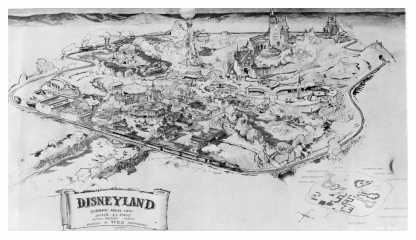
Disney has here provided us with a comment upon how the gradually increasing scale of technology has had the effect of reversing the mythology of grand historical cycles. For the Greeks, the world of their ancestors was anything but small and quaint, for they believed that the heroes of the Mycenean world that had preceded them were actually giants. The Greeks were forever finding the fossils of extinct species like dwarf elephants and other large Pleistocene mammals which they assumed were actual physical evidence that giants had once walked the earth before them. Pliny, for instance, insisted that a 35 foot skeleton of Orion had been found on Crete, while the giant bones of Ajax were said to have been discovered at Salamis. All this was consistent with the Hesiodic myth of a gradually declining and shrinking world in which the age of the Homeric gods was followed by the Mycenean epoch of great warriors like Achilles and Odysseus, which was followed in turn by the age of mere men in which the Greeks saw themselves as living. This sense of the gigantism of a mythical past looming over the present continued down into the Middle Ages, when such relics as a mammoth molar and an elephant vertebra were venerated as evidence of the historical reality of the giant Saint Christopher.
It is only in the twentieth century, as a result of the gradually increasing scale of our own technologies, that the world of our ancestors has come to seem small and quaint, for that world has been dwarfed by our nuclear reactors, atom bombs, skyscrapers and jumbo jets. What monument of the ancients, save perhaps the pyramid of Cheops (or possibly the Colossus of Rhodes) could be held up against Hoover Dam and the Golden Gate Bridge for sheer scale of gigantism? In a roundabout way, then, we have come by means of the path of ever larger forms of technology to reversing the mythology of history, so that now we have become the giants looming over the shrunken old men of our Norman Rockwell past.
Thus, the visual effect as one strolls down Disney's Main Street, USA, is to subtly make one feel like a giant who has outgrown his parents' limited horizons and narrow vistas. This feeling is not an accident, either, for it is part of Disney's vision of the unlimited path to progress of technology which he naively believed would make better human beings out of us. He was almost completely unaware of the shadow side of technology and the damage it has done, not only to the environment, but to the humanities and the arts, which have been left in a state of nearly total disarray, like a trawler in the wake of a Titanic. Indeed, his faith in the unlimited vistas opened up before us by the potentialities of new technologies is so naïve that it is almost charming. The title of the pavilion which Disney, with the help of fellow colossus Robert Moses, designed for General Electric at the 1964 New York World's Fair says it all: "The Carousel of Progress."
And yet, the disconnected tableaux of Disneyland lay right there in front of him as evidence to the contrary, for as Neil Postman was always fond of pointing out, the one thing we forget to ask whenever any new technology comes along is, What way of life will this new gadget undo? For just as the advent of the printing press heralded the twilight of the Middle Ages and brought about the erosion of the use of Latin as a language of international learning — while also decentralizing the Church's power through mass producing the Bible in vernacular tongues — so too, Frontier Land, with its Romantic cowboyism and its Fenimore Cooper heroics was undone by the arrival of Main Street, USA, with its quaint barber shops, drug stores and Weekly Bugle newspapers. And Main Street, USA, in turn, was undone by the huge freeway systems of the fifties which made small towns irrelevant and burst open the seams of the city to spill forth a massive sprawl of decentralized suburbs and shopping malls.
All of these changes, without exception, were brought about by the advent of new technologies, the yearly proliferation of which has continued to make change the norm of our society. Disney's nostalgia for his vanished small town America moved him to create Disneyland as a museum of vanished worlds whose ends were brought about by the very sorts of technology which Disney enthusiastically endorsed in the creation of his theme park.
Of Automobiles & Parking Lots
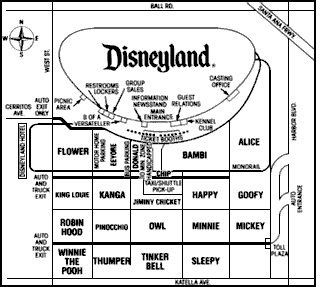 There is actually one aspect of the shadow side of technology that Disney was aware of, and which is implicit in the very structure and layout of Disneyland itself. When we pay attention to the world that Disneyland excludes by means of the boundary established by the railroad which formed the park's original perimeter, we notice that it is precisely the automobile that must remain on the outside and is not allowed to enter the park's interior. "Walt had always intended to transport his guests to a separate place," Neal Gabler writes, "and he once scolded a publicist who had parked his car where it could be seen from the Mark Twain because passengers in 1860 could not possibly imagine an automobile from 1955." (Gabler, 534) There is actually one aspect of the shadow side of technology that Disney was aware of, and which is implicit in the very structure and layout of Disneyland itself. When we pay attention to the world that Disneyland excludes by means of the boundary established by the railroad which formed the park's original perimeter, we notice that it is precisely the automobile that must remain on the outside and is not allowed to enter the park's interior. "Walt had always intended to transport his guests to a separate place," Neal Gabler writes, "and he once scolded a publicist who had parked his car where it could be seen from the Mark Twain because passengers in 1860 could not possibly imagine an automobile from 1955." (Gabler, 534)
One of the unintentional creations of Disneyland is the Mother of All Parking Lots (12,000 car capacity), the world's largest up to that time. Indeed, this may be the first parking lot in the world so large as to actually have vanishing points between the car lanes as they disappear into perspectival space along the blue horizon. The automobile is the enemy of the various worlds captured and preserved in formaldehyde by Disney, since the automobile has an inherently decentralizing effect upon cities and communities everywhere. Small Town, USA, was ultimately strangled out of existence by the weight of cloverleaves, expressways, and overpasses; its air saturated with carbon emissions, dust, and black grime.
It is significant in light of this that Disney's plans for the creation of his artificial city, EPCOT, did not allow for automobiles inside the city. "Here, the pedestrian will be king," he said, "free to walk and browse without fear of motorized vehicles," and so he exiled automobiles to a level underground from which they were never to be allowed to emerge. The disintegrative impact of the automobile upon cities may be the one example of the shadow side of technology that Disney ever recognized.
By demanding that one leave the car behind as part of the mass exodus from the suburbs to visit the new American Mecca of Disneyland, the very structure of the park itself actually casts into high relief the automobile culture of the fifties, a world of parking lots, shopping malls, freeways and interstate highways. The Austrian architect Victor Gruen had, in the early fifties, invented the bi-level indoor shopping mall. His designs were rapidly infiltrating American culture at just the time when the construction of the Interstate Highway systems were knitting the country together with a tangled mesh of black ribbons of asphalt scarring the countryside and transforming the land into a mere scenic backdrop. The 1950's were the advent of the Automobile Society, which led to the creation — especially out West — of huge soulless megalopolises like Los Angeles (which at this time did away with its Pacific Electric rail transportation system) and Phoenix (where the last streetcar was shut down in 1948). In these places pedestrians are a rarity and, as a result, so too is real culture, for culture depends for its existence upon the friction generated by serendipitous contacts of human beings with one another. Sheltered and cut off from such contact by their metallic exoskeletons, automobiles not only isolate people from one another, numbing their human sensibilities, but they transform them into impersonal units who are all too ready to resort to violence to solve their fleeting traffic conflicts.
Places like Phoenix, Dallas, and Los Angeles are arranged around, and give preference to, machines rather than people. The idea of a city in which pedestrians are a rare occurrence is a travesty of the very idea of civic life, and a degradation of the human spirit. Indeed, we might even go so far as to say that such places are not really cities at all, for cities have traditionally existed to serve human beings and their needs, but in these non-places such age old values have been discarded as superfluous. The very design and layout of a non-place like Phoenix implies a philosophy in which human beings are irrelevant and are born, like drones, merely to serve the Megamachine. The autopolis is perhaps humanity's ultimate fall into the nadir of materialism. It is truly a Hell on Earth.
Of Utopias & Cosmocrators
During the last years of his life, Walt Disney decided that he wanted to become a god. He bought some real estate in Florida, roughly 27,000 acres worth — twice the size of Manhattan — with the intention of erecting upon it an entire city. He called this city EPCOT, an anagram for "Experimental Prototype Community of Tomorrow," and announced to the world that it would have a population of about 20,000 people. The city was to be built on a radial plan; that is to say, in the shape of a circle, with concentric bands of development radiating outward from a central hub of skyscrapers, including belts of suburban residences, schools and churches, parks, etc. Monorails would bring commuters from the outlying areas to the central hub of the city to work, where People Movers would then shift them about from place to place. Automobiles and trucks would be confined to lower levels beneath the city. And, for a final touch of megalomania, the entire city would be enclosed by a huge dome of glass in order to provide climate control. As Disney's friend Robert Moses described it, EPCOT would have been the "first accident free, noise free, pollution free city center in America." (Gabler, 610)
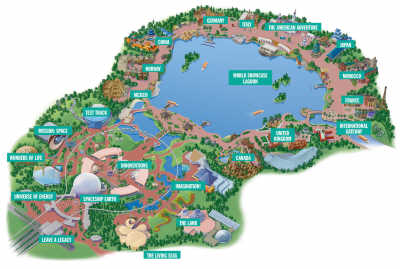
Disney did not live to see his experimental community built, but it is likely that had he lived another fifteen or so years, he would somehow have found a way to bring it into being. And it is equally likely that the city would have been a monumental failure, because its utopian dream of the elimination of all forms of pollution is unrealistic in the extreme. Human beings are messy creatures and they bring their messes with them wherever they go. They cannot live in laboratories, or in macro-scale versions of laboratories like space stations and Martian colonies, for very long. EPCOT was nothing if not a prototype Martian colony, like Biosphere II in Oracle, Arizona, a similar experiment inside a sealed environment which, we note, was a complete failure.
Disney's dream is an antiseptic one, as purged from contamination by the senses as Plato's fantasy of the soul's flight from the caverns to the heavenly sun. It is a disguised dream of building the New Jerusalem on earth, for in the Book of Revelation, the New Jerusalem was essentially a spaceship that descended from the heavens to the top of a mountain in order to pick up its cargo of Christian passengers for the millennium. Disney's vision is a desired fulfillment of constructing the New Jerusalem by means of technological progress. If all history has been tending towards a goal, it is that of the perfection of technology to such a point of ethereal subtlety that it will enable the realization of the City of God upon earth. Disney's plan to build a city beneath a glass dome is a macroscale version of the modelmaker's dream of placing a ship inside a bottle, itself a vision of complete desire for god-like mastery over a microcosm. Indeed, the city inside a glass dome is a vision nearly identical to Hieronymous Bosch's "Creation of the World," (c. 1466) which depicts the earth as a flat disc sealed off inside an enormous glass sphere, over which Yahweh broods in the outer firmament above. With the glass dome, Disney even thinks he can control the weather, something that only a god could do, and which truly reveals him in his last fantasy as aspiring to an apotheosis.
For his final act, then, Disney wished to put on the mask of cosmocrator and to shrink his fellow human beings down to the size of lab rats. Thus, the arc of his career had taken him from playing the mouse in the maze battling obstacles at every turn, to becoming the white-coated man who hovered over the maze and pushed the buttons.
Of Death & Sleeping Kings
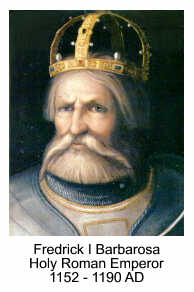 The urban legend that Walt Disney was cryogenically frozen at death and merely awaits the hour when science will come round at last with the proper technology to resurrect him, though factually false — since Disney was actually cremated, not frozen — is nevertheless inwardly true. Such a belief, if Disney had professed it, is perfectly consistent with his almost religious faith in the ever ascending perfection of the progress of science. But more importantly, the urban legend suits the mythical contours of the life which Walt Disney lived, which, as we have seen, was a gradual ascent toward a self-apotheosis as cosmocrator. The legend is a translation into the language of science fiction of the very well known myth of the return of the sleeping king or god who has died and merely awaits the proper moment when he will come forth once again. The Celts, for instance, believed that the warrior hero Fionn had never really died, but had gone to sleep in a cave and presently awaits the moment when Ireland will summon him forth once again in her hour of need. There is a similar legend concerning the prophesied return of the German ruler Frederick I Barbarossa, in which it is said that he is not dead but sleeping with his knights in a cave in the Kyffhauser mountain in Thuringia, and that when the ravens cease to fly, he will arise once more. Indeed, it is a common enough legend. The urban legend that Walt Disney was cryogenically frozen at death and merely awaits the hour when science will come round at last with the proper technology to resurrect him, though factually false — since Disney was actually cremated, not frozen — is nevertheless inwardly true. Such a belief, if Disney had professed it, is perfectly consistent with his almost religious faith in the ever ascending perfection of the progress of science. But more importantly, the urban legend suits the mythical contours of the life which Walt Disney lived, which, as we have seen, was a gradual ascent toward a self-apotheosis as cosmocrator. The legend is a translation into the language of science fiction of the very well known myth of the return of the sleeping king or god who has died and merely awaits the proper moment when he will come forth once again. The Celts, for instance, believed that the warrior hero Fionn had never really died, but had gone to sleep in a cave and presently awaits the moment when Ireland will summon him forth once again in her hour of need. There is a similar legend concerning the prophesied return of the German ruler Frederick I Barbarossa, in which it is said that he is not dead but sleeping with his knights in a cave in the Kyffhauser mountain in Thuringia, and that when the ravens cease to fly, he will arise once more. Indeed, it is a common enough legend.
The fact that this same myth has grown up around Walt Disney is an indication that he is yet another example of a Cold War celebrity who is slowly, but inevitably, on the way toward transformation into a divinity. He is one of the saints of our world of electronic stained glass, for as time goes by, legendary powers continue to accrete to him, elevating rather than diminishing his god-like reputation. Mere celebrities are shadowy figures whose fame rarely outlasts even their own lifetimes, but electric demigods become more gigantic with the passing of years. Indeed, the particular urban legend of Disney's cryogenic preservation is so prevalent that most people assume it is true; even the French philosopher Jean Baudrillard, in his various writings about Disney, takes it as a given. This is precisely how myth slowly rises up like the thistles surrounding the castle of Sleeping Beauty, and gradually begins to replace historical reality with the more profoundly true reality of mythology. One day, the legend simply stops being questioned and everyone takes it for the truth. This is how historical figures are elevated to the status of mythical heroes and gods.
It is, after all, not too difficult to believe. Disney really was a master of technological potentialities who was always on the lookout for new developments in order to bring them into the service of his City of Progress. If anyone could find a way to defeat death and come back again, it would surely have been Walt Disney.
Works Cited
- Gabler, Neal.
Walt Disney, The Triumph of the American Imagination. NY: Alfred A. Knopf, 2006.
- Eliade, Mircea, The Forge and the Crucible: The Origins and Structure of Alchemy. Rider & Co., London, 1962.
- McLuhan, Marshall. The Gutenberg Galaxy. Toronto: University of Toronto Press, 1997.
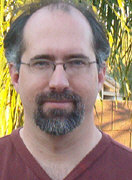 John David Ebert is a former editor for the Joseph Campbell Foundation. He wrote footnotes for Baksheesh & Brahman, Sake & Satori and The Mythic Dimension, all posthumous publications of Campbell's writings. His first book was Twilight of the Clockwork God: Conversations on Science and Spirituality at the End of an Age John David Ebert is a former editor for the Joseph Campbell Foundation. He wrote footnotes for Baksheesh & Brahman, Sake & Satori and The Mythic Dimension, all posthumous publications of Campbell's writings. His first book was Twilight of the Clockwork God: Conversations on Science and Spirituality at the End of an Age (Council Oak Books, 1999). His most recent book is entitled Celluloid Heroes & Mechanical Dragons: Film as the Mythology of Electronic Society
(Council Oak Books, 1999). His most recent book is entitled Celluloid Heroes & Mechanical Dragons: Film as the Mythology of Electronic Society (Cybereditions, 2005), and was reviewed by Dr. William Doty in the August 2005 issue of Mythic Passages. His work has been published in various periodicals such as Utne Reader, The Antioch Review, Lapis and Alexandria. He is currently working on a book about popular culture and mythology, tentatively entitled Electric Demigods of the Lightspeed World. (Cybereditions, 2005), and was reviewed by Dr. William Doty in the August 2005 issue of Mythic Passages. His work has been published in various periodicals such as Utne Reader, The Antioch Review, Lapis and Alexandria. He is currently working on a book about popular culture and mythology, tentatively entitled Electric Demigods of the Lightspeed World.
Read more by John Ebert at his website cinemadiscourse.com
Return to Passages Menu
Subscribe to the Passages e-zine
|
